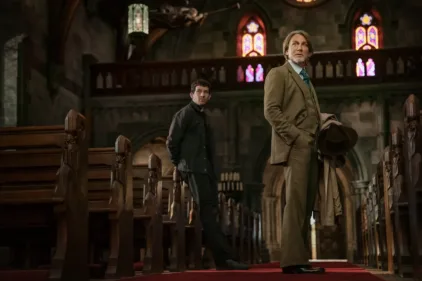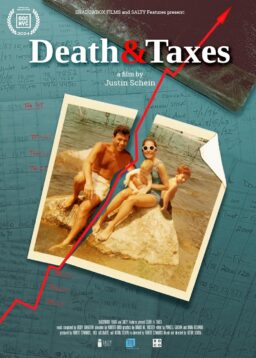“That was my bedroom window, right up there,” Hugh Hefner said. He was standing on the grass in the front yard at 1922 N. New England, with half a dozen friends and relatives who had joined him on a trip back to the old neighborhood. “The Smiths lived down there,” Hefner’s brother Keith said. “Yeah, and crazy old lady Johnson,” Hefner said. “She later hung herself.” “Let’s go around in back,” said Keith. The brothers walked down the sidewalk next to the neat two-story house as if they could have done it in their sleep. “They’ve enclosed the back porch,” Hefner observed. “That’s where we used to play pirates. I was the kid in the neighborhood who always created the games.” “The neighborhood has really kept its quality,” Keith said. “It looks good.”
“Everything is so clean,” Hefner said.
“They paved the alley,” Keith said. “It used to be cinder. A lot of these houses were prairie then.” “Prairie?” asked a visitor from out of town.
“That’s what you called a vacant lot in Chicago,” Hefner said. “When I was a child, the street lights were still gas. And you got your milk and coal and ice delivered by horse-drawn wagons.”
“You could hear the horses clomping down the street,” Keith said. “They knew the routes by heart.”
“And at night, you could hear the train whistles,” Hefner said. “One of the loveliest sounds in the world.” He reached out impulsively and hugged his brother, who is a couple of years younger than he is. “Wanna walk over to the park?” he said. “Sure,” said Keith. They set off down the block toward Sayre Park, two multimillionaires coming back to see where they were raised. For years it seemed as if the party would never stop for Hugh Hefner, who founded the Playboy empire and ran the magazine as an extension of his famous lifestyle. The Playmates came and went, the Bunnies and their bunny-dip flourished and faded, and Hefner alone endured, presiding over a permanent house party, at first in the fabled Playboy Mansion on State Parkway in Chicago, and since 1971 in the Mansion West, in Holmby Hills, up the hill from Beverly Hills.
Then came the stroke, the coronary event that brought Hefner to a standstill half a dozen years ago. It was nature’s way of requesting his attention, and so sobered Hefner that after his recovery, he stopped playing the permanent host in his own home, and eventually did what he calls “the unthinkable’ – he married and began a second family, 40 years after his first marriage to a sweetheart named Millie, whose daughter Christie is now running the family business.
All of this and more is to be found in “Hugh Hefner: Once Upon a Time,” a documentary of Hef’s life and times which premiered Wednesday in the Chicago Film Festival and will open Friday in Chicago, New York and Los Angeles. Hefner brought his second wife, a former Playmate of the Year named Kimberley Conrad, back to Chicago for the premiere and a trip to the haunts of his childhood. He also brought their 2-year-old son, Marston, although the baby, Cooper, was too young to make the trip.
“I got my library card in the Sayre Park clubhouse,” Hefner was saying, marching across the grass toward a viaduct. “Remember this park, Keith? This is where that girl from your class brought all the boys.”
“Jeez, I wonder what happened to her,” Keith said.
“Remember, she came to school in that coat with the fur collar?”
“Very advanced for her age.”
“Here’s the viaduct.”
“We used to think this was haunted at night.”
“Remember this, Betty?” Hefner was talking to Betty Conklin, the girl he had a crush on in high school. She lives in San Francisco now, but he’d invited her back for the premiere. “Remember the time we went to the square dance with your family?”
She did. The park clubhouse was open, and Hefner walked in on a gymnastics class, smiled and waved, and then wandered down a hallway to a room that was empty now, but still had the faded word “Library” painted above the door.
“The first book I took out was The Insidious Dr. Fu Manchu,” he said.
A rented bus had followed the group down the street, and now Hefner and what remained of his party climbed on board. It had already been a long day; Kimberley had gone back to the hotel with Marston, who had slept badly and was fretful. Hefner settled down in a leather seat, asked for a Diet Pepsi, and seemed content. For every generation, I told him, there is one man who gives the famous parties. There was Gatsby in the 1920s. And for my generation, there was you. “Yes,” he said, “but I knew I couldn’t swim.” He was remembering Scott Fitzgerald’s novel, in which Gatsby stands at the end of his pier and looks out over the dark waters to the light that shines at the end of the dock where Daisy Buchanan lives. Daisy, the girl he wanted but could not have. There were not many girls like that for Hugh Hefner. “Fitzgerald said American lives don’t have a second act,” he said. “I’ve had three. Playboy was my second. This is my third. I had been working on my autobiography for years, and the day I married Kimberley, I turned to my collaborator and said, `Now we have the last chapter.’ ”
The first chapter had begun on New England Avenue. The second was in Sayre School. When our bus pulled up in front of it, Hefner got out, and remembered the huge sandbox that used to be in the front yard. The third and fourth chapters were at Steinmetz High School, where “Hugh” was shy his first and second years, and then reinvented himself as “Hef,” according to the documentary, and went on to have the happiest years of his life. We visited Steinmetz, too. Hefner led the crowd into the principal’s office, where coffee and cookies were set out, and remembered the time he’d been called on the carpet for defending the jitterbug in the school paper. He visited the small room where the Steinmetz Star is still published. He noted that the sign outside a restroom said “Women.” In his day it had said “Girls.” And he met with a group of some 40 honor students. He did not tell them he was the founder of Playboy magazine. Maybe he thought they knew that. He did tell them he wrote for the Star, and was a member of the Green Curtain Players, and the yearbook staff, and was voted most popular senior and class comedian. “This is where I first dreamed the dream,” he told the students.
“I graduated in January, 1944. This is my brother Keith. He graduated in June, 1946. This is Betty Conklin. I had a crush on her in my summer of ’42. I know all that seems like a million years ago for you. It’s a minute and a half for me.” He asked for questions. There were a lot of them: How did you get the idea for your “franchise”? Do you feel your magazine degrades women? How do you choose the Playmates? What do they get paid? Were you popular as a student? What did your parents think about Playboy? “My mother was once asked if she was proud of me,” Hefner said. “She said she was proud, yes – but she would have been just as happy if I’d been a missionary.” The students laughed. “I told her, ‘Mom, I was.’ ”
Outside, in the crisp October air, there was a football practice under way.
“Remember the old school cheer?” asked Betty. The three graduates chanted it together: “Charles Proteus Steinmetz. . . Charles Proteus Steinmetz. . . Charles Proteus Steinmetz. . . Fight!” Another one of Hefner’s stops was not far away, at the Montclare Theater. Hefner climbed out of his bus and looked uneasily at the sign on the marquee, which read, “For Sale: Two acres.” He looked around and said, “This was Woolworth’s, where I bought all the Big Little Books. Keith still has all of his. Over there is where Betty used to work behind the soda fountain.” “No it wasn’t,” said Betty Conklin. “It was on the other corner, Hugh.” “Was it?” “I remember the day I got off work with my $11 paycheck for 44 hours and lost it at the movies.” “I got $9.50 a week ushering at the Rockne,” Keith said. “Remember those uniforms?” Hefner said. “You had a stiff shirt front, but it was cardboard. No shirt underneath, but cardboard cuffs showing beneath your jacket. Gee, maybe that’s where I got the idea for the cuffs on the Bunny uniforms.”
“Keith! Remember me?” asked an attractive blond woman walking past on the sidewalk. “We starred in the senior play together!” “My God, we did,” said Keith. It was Eleanor Schmider. “I still live in the same house,” she said. “The man who owns the theater is going to unlock it for us,” Hefner’s secretary told him. We all walked across the street, and the man unbolted the doors, and we walked inside. He found the light switch, and the theater sprang back into life, surprisingly well-preserved. We walked through the tall old lobby. “There was a little fish pond here, with a mermaid sitting next to it,” Betty remembered. We walked into the empty auditorium, where the screen was torn but the seats still waited for another audience. “Look at this place,” Hefner said. “All the dreams were there on the screen.” He stood in front of the stage and looked back at the vast empty palace. “This is the only thing that is larger than I remember it.”











